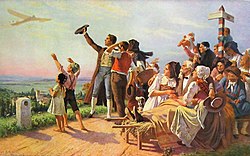Albert Bettannier
Albert Bettannier | |
|---|---|
| Born | 12 August 1851 Metz, France |
| Died | 17 November 1932 (aged 81) Paris, France |
| Known for | Painting |
Nicolas Albert Bettannier (12 August 1851 – 17 November 1932) was a French painter in the era of the French Third Republic.[1]
Life[change | change source]

Bettannier was born in Metz in 1851. He was the son of Jean Bettannier and Marie Bellatte. He studied in the Moselle department in France.[2] When a place called Alsace-Lorraine, where he was from, was taken away by Germany because France lost the Franco-Prussian War, he wanted to stay French and went to live in Paris. He studied in the Académie des beaux-arts. There, Henri Lehmann and Isidore Pils were his teachers. Starting from the year 1881, his paintings were often shown in the Salon des artistes français. His paintings were often about losing Alsace-Lorraine.[3][4]
Albert Bettannier got the Legion of Honour in 1908.[5]
He died on 17 November 1932 and his funeral was at Vaugirard Cemetery in Paris.
Work[change | change source]
- La Tache noire (The Black Spot), Deutsches Historisches Museum, Berlin, 1887
- Le désespoir (The Despair), Musée de l'Ermitage, Saint-Pétersbourg, 1893
- La Conquête de la Lorraine (The Conquest of Lorraine), 1910
- L'Oiseau de France (The Bird of France), 1912.
Gallery[change | change source]
-
The Black Spot or The Geography Lesson, 1887
-
Le Désespoir ou Les Annexés en Lorraine, 1883
-
Les Annexés en Alsace, 1911
-
The Bird of France, 1912
-
Enchères à l'Hôtel Drouot, 1921
Other websites[change | change source]
References[change | change source]
- ↑ "Albert Bettanier (3544)". www.musee-orsay.fr. Musée d'Orsay. Retrieved 28 January 2024.
- ↑ "Ministère de la culture - Base Léonore". www2.culture.gouv.fr. Retrieved 22 February 2024.
- ↑ François Robichon. "L'annexion de l'Alsace et de la Lorraine - Histoire analysée en images et œuvres d'art". L'histoire par l'image (in French). Retrieved 28 January 2024.
- ↑ Explication des ouvrages de peinture, sculpture, gravure, lithographie et architecture des artistes vivants, étrangers et français, exposés au Palais des beaux-arts. 1855.
- ↑ "Ministère de la culture - Base Léonore". www2.culture.gouv.fr. Retrieved 22 February 2024.





